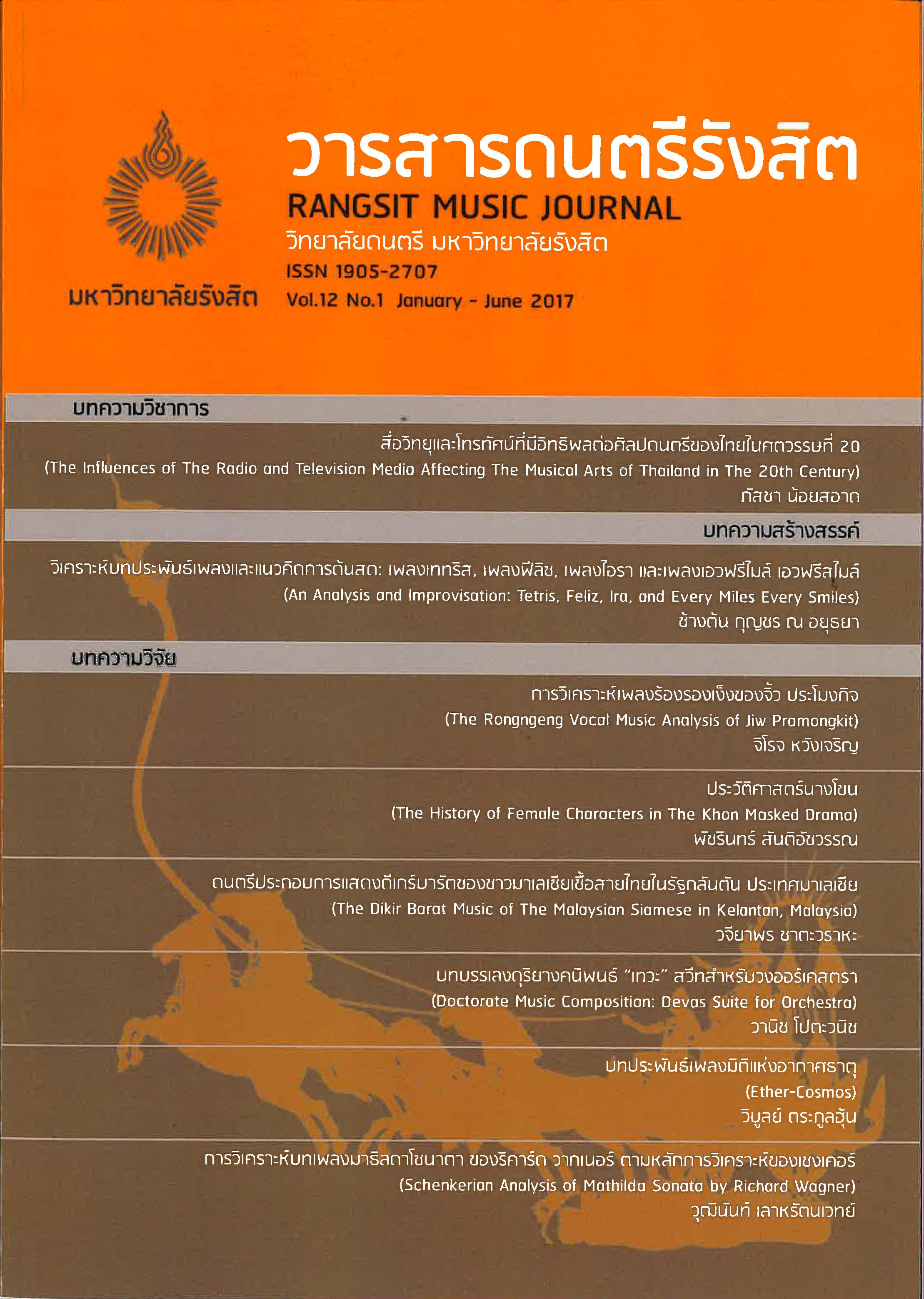The Dikir Barat Music of the Malaysian-Siamese in Kelantan, Malaysia
Keywords:
Dikir Barat, Music, Malaysian-SiameseAbstract
This research is a qualitative research in ethnomusicology which aims to 1) study the general background of the Malaysian-Siamese in Jambu Village, Tumpat Sub-district, Kelantan State of Malaysia 2) study the elements of Dikir Barat music which are; historical background, performing elements, musical instruments, ensemble, musicians, and performing occasions 3) transcribe the music into standard notation and analyze the songs in ethnomusicological methods. The research results are: 1) The Kelantan formerly was a partial region of the Kingdom of Siam until the year 1909 the state’s become a part of Malaysia until today. However, the regional inhabitants are mostly Thai descendants who have well maintained the cultural heritages from their ancestors. 2) The Dikir Barat originated and influenced from Dikir Hulu of the southern Thailand and later spread out through the northern regions of Malaysia. The Dikir Barat, a folk performing art, is a proverb singing style in call and response character between the leaders called Tukang Karut as well as Tukang Yani and the group called Yor-lah who also followed the musical rhythm by moving their bodies as well as clapping hands while sitting. Musical instruments comprise of Gendang I-bu, Gendang Anak, Canang, Gong, Buah Ram Ba, Tam Bu Ring and Ke-Si. The musical troupe entitle is Seri Jambu which are performed only for entertainments. 3) The music is transcribed into standard notation comprise of 6 important songs: Berg Rong (Overture), Sungai-padi, Tukang Karut, I-kea Puyu, Usaba and Warbulear. Most of the songs are vocal music except the overture is the instrumental music. The song forms, mostly have ornamentation, are strophic, binary as well as ternary in pentatonic, hexatonic and heptatonic tone sets with both constant and undulating in melodic contour. The melodic repetitions are found in some songs. The three main tempos; free rhythm, slow, and fast, are found among these songs which are difference in rhythmic patterns of each percussion instruments.
References
2. ณัชชา โสคติยานุรักษ์. สังคีตลักษณ์และการวิเคราะห์. พิมพ์ครั้งที่ 2. กรุงเทพฯ: สำนักพิมพ์แห่งจุฬาลงกรณ์มหาวิทยาลัย, 2544.
3. ณัฎฐาพร หอมแช่ม. “ลิเกฮูลู: กรณีศึกษาคณะอาเนาะป อุมารอ์าเนาะปูยู อำเภอแม่ลาน จังหวัดปัตตานี.” ปริญญานพินธ์ศิลปกรรมศาสตรมหาบัณฑิต, มหาวิทยาลยัศรีนครินทรวิโรฒ, 2548.
4. นิพนธ์ ทิพย์ศรีนิมิต. “อัตลักษณ์ทางวัฒนธรรมของคนไทยในรัฐกลันตัน ประเทศมาเลเซีย.” ใน การประชุมสัมมนาทางวิชาการเรื่องไทศึกษา: กรณีคนไทยในรัฐทางตอนเหนือของประเทศมาเลเซีย. สงขลา: สถาบันทักษิณคดี, 2553.
5. ประพนธ์ เรืองณรงค์. ลิเกฮูลูศิลปะการแสดงไทยภาคใต้. สงขลา: บริษัทเอสพริ้นท์จำกัด, 2552.
6. วีระ สุวรรณ และแฮลาย ปรามวล. บันทึกมรดกวัดไทยในรัฐกลันตัน. สงขลา: เทมการพิมพ์, 2553.
7. ศรัณย์ นักรบ. “บทพิลาปมะระเสี่ยในพิธีมุฮัรรอมของชาวมุสลิมนิกายชีอะห์ในประเทศไทย.” วารสารมนุษยศาสตร์ 20, 1 (มกราคม-มิถุนายน 2556): 159.
8. เอห์แดง ชิกค์. ผู้ก่อตั้งวงเซอรีจัมบู. สัมภาษณ์. การแสดงดีเกร์บารัตในมาเลเซียและประวัติของวงเซอรีจัมบู. 8 กรกฎาคม 2554.
9. Dournon, Geneviève. Handbook for the collection of traditional music and musical instruments. 2nd ed. Vendôme: Presses Universitaires de France, 2000.
10. Sadie, Stanley. The New Grove Dictionary of Music and Musicians. London: Macmillan Publishers Limited, 1980.







